Presentation of the special issue of China Perspectives, “Sinophone Musical Worlds (2): The Politics of Chineseness” by the authors:
To celebrate Make Music Day on June 21, we have gathered all the songs and music videos mentioned in the new issue of China Perspectives, “Sinophone Musical Worlds (2): The Politics of Chineseness”.
“Editorial: Contesting and Appropriating Chineseness in Sinophone Music” by Nathanel Amar
Songs of the Hong Kong protests in the Sinophone world:
“Glory to Hong Kong” 願榮光歸香港, by thomas dgx yhl (2019)
“撐” by The Chairman, Denise Ho, etc. (2019)
“Glory to Hong Kong” 願榮光歸香港 Taiwanese version by The Chairman (2020)
Songs for the Taiwanese 2020 presidential elections
“Captain Taiwan” 台灣隊長, by Dwagie 大支 (2019)
“自信勇敢 咱的名” by Fire Ex 滅火器 (2019)
Songs about the COVID-19
“Fight As One” by Eason Chan and Jolin Tsai (2020)
“Stay With You” by JJ Lin and Stefanie Sun
“WHO” by Dwagie 大支 (2020)
“Relocating the Functions of Chineseness in Chinese Popular Music after the China Wind” by Chen-Yu Lin
While the popularity of China Wind (zhongguofeng 中國風) music during the 2000s has waned somewhat since its peak, the notion of Chineseness in popular music requires reconfiguration. In the world of popular music, transnational flows of culture, migration, and capital have created various forms of Chineseness with different functions. This article examines two ways in which the perception of Chineseness functions in the music industry, namely as a re-centred Chineseness in the creative industries, and Chineseness as a globalising project, by examining the internationally franchised televised music contest The Voice of China and the recent work of two artists known for their China Wind songs, Jay Chou and Wang Leehom. Through textual analysis of media content and songs, as well interviews with industry practitioners, this article argues that Chineseness in today’s Chinese popular music is often shaped by markets, industrial practices, media censorship, state policy, and cross-industry convergence, and musicians’ artistry increasingly plays a part in forming and authorising the representation of Chineseness in contemporary Chinese popular music.
Wang Leehom full address at the Oxford Union on Chinese pop music:
Jay Chou’s China Wind songs:
“東風破” (East Wind Breaks), 2003
“髮如雪” (Hair Like Snow), 2005
“菊花台” (Chrysanthemum Terrace), 2006
“霍元甲” (Fearless), 2006
“黃金甲” (Golden Armor), 2006
“Now You See Me”, 2016, from the movie “Now You See Me 2”
Wang Leehom’s China Wind songs
“龍的傳人” (Descendants of the Dragon), 2000
“蓋世英雄” (Hero of the Earth), 2005
“華人萬歲” (Viva Huaren), 2007
“火力全開” (Open Fire), 2011
“忘我” (Lose Myself), ft. Avicii, 2014
“Flow”, Khalil Fong ft. Wang Leehom, 2016
“緣分一道橋” (Bridge of Fate), 2017, from the movie “The Great Wall”
“聽愛” (Hearing Love), 2017, from the movie “Tofu”
“Homoeroticising Archaic Wind Music: A Rhizomatic Return to Ancient China” by Wang Yiwen
This article explores Archaic Wind music (gufeng 古風) and its implications for Sinophone articulations. Gufeng can be categorised as a particular type of music with lyrical, musical, and symbolic references to ancient China that is produced, consumed, and circulated within an online fan community. While the lyrics of gufeng music express a post-loyalist yearning to return to the fictional roots of “Cultural China,” its video adaptations deconstruct the authenticity of such cultural roots in their homoerotic subtext. Exploring the audio-visual texts of the gufeng music, I suggest that it shows a rhizomatic return to ancient China that disorients the routes to the past.
Jay Chou, “煙花易冷” (Fade Away), 2010
Bilibili Archaic Wind music videos
Bucai 不才, “參商” (The Constellations of Shen and Shang), 2013
Qiaoqiaoqiaomi 悄悄悄彌 “河圖不見長安MV” (Hetu Invisible Chang’an MV), 2014
Xinruzhongjiankumu 心如中箭枯木 “煙花易冷” (Fade Away), 2017
Lanno 愛泡芙 “劉衛同人參商” (Constellations of Shen and Shang), 2018
“Navigating and Circumventing (Self)censorship in the Chinese Music Scene” by Nathanel Amar
Although the case of “censorship” of Chinese hip-hop in January 2018 has led to extensive news coverage in the international press, it does not account for the multiple forms of musical censorship that exist in contemporary China. This article draws on observations from within the punk rock community to outline how censorship works in practice and which institutions are responsible for overseeing musical productions, from the release of albums to the management of concerts and festivals. This overview of censorship mechanisms in the Chinese music scene – including self-censorship required to release albums domestically – will highlight how to circumvent censorship, as well as the extent to which it is possible for artists to negotiate with the authorities.
Early Chinese rock and roll songs
Cui Jian 崔健 performing for the first time “一無所有” (Nothing to my Name) on national television, 1986
Black Panther 黑豹, “Don’t Break My Heart”, 1991
Tang Dynasty 唐朝, “梦回唐朝” (A Dream Return to Tang Dynasty), 1992
He Yong 何勇, “垃圾场” (Garbage Dump), 1994
Chinese punk and alternative songs
Sober 清醒 “好極了?!” (Is It Alright?!), 1997
UnderBaby 地下婴儿, “覺醒” (Awakening), 1998.
Wuliao Contingent 無聊軍隊, 1999
SMZB 生命之餅, “獻給陳懷民的歌” (A Song for Chen Huaimin), 2014
Hip-hop songs
IN3 阴三儿 “北京晚报” (Beijing Evening News), 2008
CD-REV 天賦事變, “紅色力量” (The Force of Red), 2016
GAI, “萬里長城” (Great Wall), 2018
Dwagie 大支, “Tryna Bully” (2019)
Recently censored and disappeared songs
Jacky Cheung 張學友 “人間道” (The Way of Man), 1990
Cui Jian, “一塊紅布” (A Piece of Red Cloth), 1991
Li Zhi 李志, “廣場” (The Square)
Li Zhi, “人民不需要自由” (The People Don’t Need Freedom)


